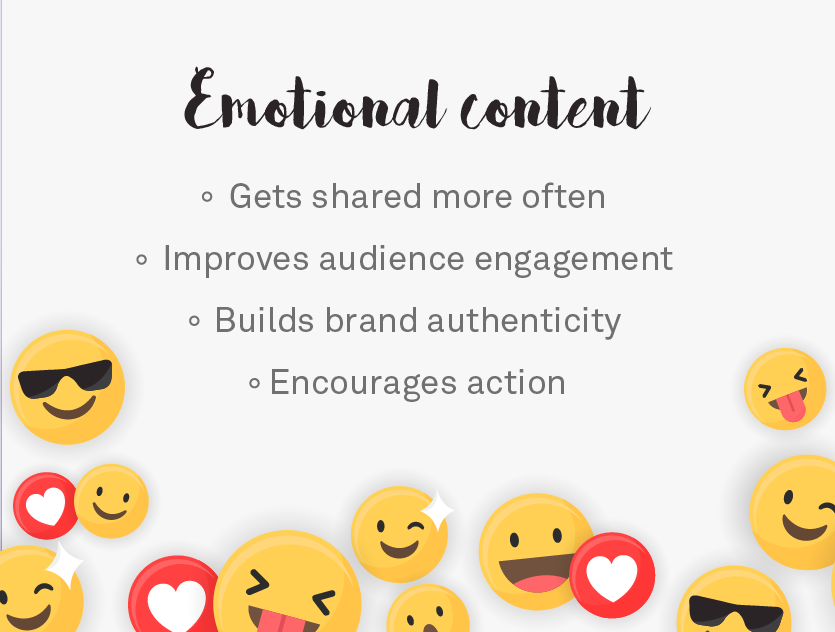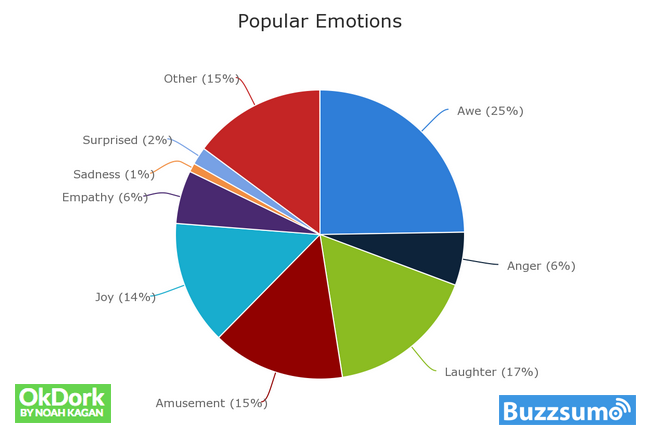

The value of creating emotional content

The key to creating compelling and convincing content? Emotional storytelling.
The heart of a company’s content marketing strategy should be its story. Stories hold great power — they can inspire new ideas, give comfort to people, and have long been a way for humans to pass on our knowledge to others.
Everyone loves a great story, and a huge part of what makes it great lies in the emotions that the story evokes.
Why create emotional content?

Emotional content gets shared more often
Did you know that some articles are more popular than others, simply because they inspired certain emotions in readers?
A study by OkDork and Buzzsumo mapped the top 10,000 most shared articles across the web to specific emotions (i.e. joy, sadness, anger) and found that the most popular emotions evoked were awe (25%), laughter (17%) and amusement (15%).
Content that generates positive emotions tends to get shared much more often than content that inspires negative feelings. So if you’re looking to make your content go viral, it’s a sound idea to ensure it makes your audience feel good.
In fact, Jonah Berger and Katherine L. Milkman, Professors from the University of Pennsylvania, studied the New York Times’ list of most-e-mailed articles discovered that one of the biggest reasons why people share articles online was because they wanted to inspire awe.
Perhaps that’s a clue as to why Nike‘s video content often seem to blow up on the net, like their 2020 ‘You Can’t Stop Us’ video.
Emotional content keeps your audience engaged
A good story creates empathy. Have you ever found yourself so engrossed in the plot of a show that you feel empty after it ends? Or perhaps you’ve been so invested in a fictional character that you actually feel a sense of loss when they get killed off as the story develops?
Targeting customer emotions is the quickest way to draw in your audience and keep them engaged.
After all, getting your audience emotionally invested helps you foster stronger bonds. Those who relate and empathise with your content tend to develop a sense of trust, loyalty and preference for your brand.
Coca-Cola’s Choose Happiness campaign, for instance, highlights events that evoke happiness, such as a wedding, young people partying, spending time with other fans in a sports stadium, and also features an Olympic winner with Down Syndrome.
Emotional content builds brand authenticity
In today’s world, consumers are seeking brand authenticity and purpose — 90% of consumers say authenticity is important when deciding which brands they like and support.
A big part of building brand authenticity lies in creating content that generates genuine emotional rapport between the brand and its target audience.
People want to connect with other people, not with impersonal corporations. Who wants to read an article that feels like it’s been churned out by computers without the capacity for genuine connections?
Even if you do use AI to create content, your authenticity should still shine through. More than just humanising your brand, this emotional connection with your consumers also encourages them to believe in your company and the values it stands for. Which pays off, especially if it’s in line with their own.
Building authenticity through emotional connections is also a reason why thought leadership content is so crucial to a brand’s marketing strategy.
By leveraging on your brand’s key leaders to bring their expertise to the table in content creation, you’re adding the ‘human’ element to the mix. It’s so much easier for your audience to connect with an actual person who shares their emotions and actual experiences.
Emotional content compels people to take action
Even though we like to think of ourselves as rational beings, our emotions play a much bigger role than we’d expect when it comes to making decisions.
The same way fear prompts us to make the choice between fight or flight, studies have shown that emotions are — for better or worse — dominant drivers of our decision-making processes.
If you’re creating content to guide your target audience along the sales funnel, it’ll be effective to appeal to their emotional sides. Especially in the consideration and conversion phase, you need to really hit them right in the feels.
In fact, the richer the emotional content of a brand’s representation in a consumer’s mind, the more likely the consumer will be a loyal user.
What builds the emotional aspect of a brand’s representation? Its narrative:
- ‘Who’ it is,
- ‘What’ it does, and
- ‘Why’ the consumer should care
Putting a price on emotions
Having emotional content tied into your brand or product can actually drive up its value in price and sales. A case in point was the Significant Objects Project, a project where 200 writers were paired with an item bought from a thrift store. They were tasked to write a fictional story behind the items’ significance.
The result?
All items were auctioned off at a much higher rate than the original price — by this we mean a 2,700% profit, which totalled US$8,000 for charity.
Think about the big brand rivalries — Pepsi vs. Coca-Cola, Apple Vs. Android — you’d most likely form a preference of one over the other. It’s often because of experience or the feeling you get when using the product, watching a video, or reading a news article about it.
The preference is not a rational one but an emotional one. In practice, the brain will try to rationalise that emotional response — it’s fizzier, has a stronger taste, looks sleeker, etc.
Creating emotional content is an essential part of your content marketing strategy. It’s no longer optional but a must to connect to your audience, especially in today’s competitive market. Emotional content allows you to stand out from the crowd and build authenticity, resulting in trust, engagement, and sales.
Want to start creating emotional content the right way? Reach out to our editorial content director, David Austin at [email protected] today!
Read more from Click2View:
- New to podcast advertising? Here’s an introduction.
- Branded videos don’t always have to be talking heads.
- Capture your audience with clever typography.
Sign up to our newsletter for a weekly update on the latest content marketing news. Don’t forget to subscribe to our YouTube channel too!
Click2View is Southeast Asia’s premiere full-service independent B2B content marketing agency servicing clients like Microsoft, Google, Visa, Prudential, and the Lee Kuan Yew School of Public Policy.









